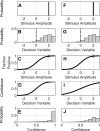A quantitative confidence signal detection model: 2. Confidence analysis
- PMID: 31215314
- PMCID: PMC6766740
- DOI: 10.1152/jn.00400.2016
A quantitative confidence signal detection model: 2. Confidence analysis
Abstract
Decision making is a fundamental subfield within neuroscience. While recent findings have yielded major advances in our understanding of decision making, confidence in such decisions remains poorly understood. In this paper, we present a confidence signal detection (CSD) model that combines a standard signal detection model yielding a noisy decision variable with a model of confidence. The CSD model requires quantitative measures of confidence obtained by recording confidence probability judgments. Specifically, we model confidence probability judgments for binary direction recognition (e.g., did I move left or right) decisions. We use our CSD model to study both confidence calibration (i.e., how does confidence compare with performance) and the distributions of confidence probability judgments. We evaluate two variants of our CSD model: a conventional model with two free parameters (CSD2) that assumes that confidence is well calibrated and our new model with three free parameters (CSD3) that includes an additional confidence scaling factor. On average, our CSD2 and CSD3 models explain 73 and 82%, respectively, of the variance found in our empirical data set. Furthermore, for our large data sets consisting of 3,600 trials per subject, correlation and residual analyses suggest that the CSD3 model better explains the predominant aspects of the empirical data than the CSD2 model, especially for subjects whose confidence is not well calibrated. Moreover, simulations show that asymmetric confidence distributions can lead traditional confidence calibration analyses to suggest "underconfidence" even when confidence is perfectly calibrated. These findings show that this CSD model can be used to help improve our understanding of confidence and decision making.NEW & NOTEWORTHY We make life-or-death decisions each day; our actions depend on our "confidence." Though confidence, accuracy, and response time are the three pillars of decision making, we know little about confidence. In a previous paper, we presented a new model - dependent on a single scaling parameter - that transforms decision variables to confidence. Here we show that this model explains the empirical human confidence distributions obtained during a vestibular direction recognition task better than standard signal detection models.
Keywords: confidence calibration; confidence rating; decision making; probability judgments; thresholds; vestibular.
Conflict of interest statement
No conflicts of interest, financial or otherwise, are declared by the authors.
Figures









Similar articles
-
Confidence in masked orientation judgments is informed by both evidence and visibility.Atten Percept Psychophys. 2018 Jan;80(1):134-154. doi: 10.3758/s13414-017-1431-5. Atten Percept Psychophys. 2018. PMID: 29043657
-
Visual Confidence.Annu Rev Vis Sci. 2016 Oct 14;2:459-481. doi: 10.1146/annurev-vision-111815-114630. Epub 2016 Aug 3. Annu Rev Vis Sci. 2016. PMID: 28532359 Review.
-
Uncertainty information that is irrelevant for report impacts confidence judgments.J Exp Psychol Hum Percept Perform. 2018 Dec;44(12):1981-1994. doi: 10.1037/xhp0000584. J Exp Psychol Hum Percept Perform. 2018. PMID: 30475052
-
Variance misperception explains illusions of confidence in simple perceptual decisions.Conscious Cogn. 2014 Jul;27:246-53. doi: 10.1016/j.concog.2014.05.012. Epub 2014 Jun 19. Conscious Cogn. 2014. PMID: 24951943
-
Optimal metacognitive decision strategies in signal detection theory.Psychon Bull Rev. 2025 Jun;32(3):1041-1069. doi: 10.3758/s13423-024-02510-7. Epub 2024 Nov 18. Psychon Bull Rev. 2025. PMID: 39557811 Free PMC article. Review.
Cited by
-
Vestibular perceptual thresholds for rotation about the yaw, roll, and pitch axes.Exp Brain Res. 2023 Apr;241(4):1101-1115. doi: 10.1007/s00221-023-06570-4. Epub 2023 Mar 4. Exp Brain Res. 2023. PMID: 36871088
-
Noisy galvanic vestibular stimulation induces stochastic resonance in vestibular perceptual thresholds assessed efficiently using confidence reports.Exp Brain Res. 2024 Dec 24;243(1):34. doi: 10.1007/s00221-024-06984-8. Exp Brain Res. 2024. PMID: 39718639
-
Vestibular Precision at the Level of Perception, Eye Movements, Posture, and Neurons.Neuroscience. 2021 Aug 1;468:282-320. doi: 10.1016/j.neuroscience.2021.05.028. Epub 2021 Jun 2. Neuroscience. 2021. PMID: 34087393 Free PMC article. Review.
-
Your Vestibular Thresholds May Be Lower Than You Think: Cognitive Biases in Vestibular Psychophysics.Am J Audiol. 2023 Nov;32(3S):730-738. doi: 10.1044/2023_AJA-22-00186. Epub 2023 Apr 21. Am J Audiol. 2023. PMID: 37084775 Free PMC article.
References
-
- Benson AJ, Hutt EC, Brown SF. Thresholds for the perception of whole body angular movement about a vertical axis. Aviat Space Environ Med 60: 205–213, 1989. - PubMed
-
- Benson AJ, Spencer MB, Stott JR. Thresholds for the detection of the direction of whole-body, linear movement in the horizontal plane. Aviat Space Environ Med 57: 1088–1096, 1986. - PubMed
Publication types
MeSH terms
Grants and funding
LinkOut - more resources
Full Text Sources

